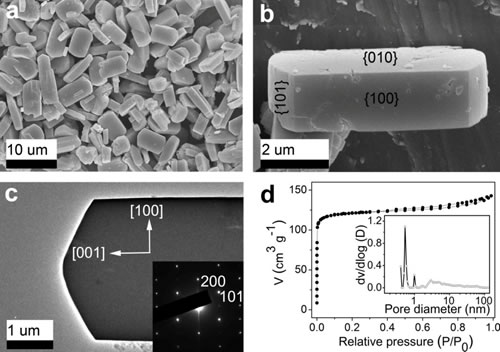
(a) SEM images of highly dispersed Si-ZSM-5@GO crystals; (b) SEM images of individual Si-ZSM-5@GO crystals; (c) TEM images of Si-ZSM-5@GO zeolite crystals and The in-situ electron diffraction pattern indicates that the crystal grows along the c-axis; (d) Argon adsorption and desorption curves and pore size distribution diagrams.
Graphene oxide (GO) is an important precursor for synthetic graphene materials. Its surface contains various functional groups such as hydroxyl, epoxy, carboxyl, etc., which provides favorable conditions for the preparation of graphene composites. However, the interaction between these polar functional groups and the crystal faces of inorganic materials limits the controlled growth of the crystallization of inorganic materials.
A team member of the Institute of Physical and Chemical Technology of the Chinese Academy of Sciences, Dr. Jianxin Jian, used the selective action between different crystal faces of GO and zeolite crystals to achieve controlled growth of inorganic materials in the graphene system, producing highly dispersed, multicrystalline surfaces containing Multi-well structure, Si-ZSM-5 zeolite crystals grown along the c-axis orientation. As shown in the figure, by adding GO in the solvent-free synthesis, the aggregation of Si-ZSM-5 zeolite crystals was suppressed, and highly-dispersed Si-ZSM-5 crystals were obtained; it was found that GO was added with solvent-free synthesis. As the amount increases, the Si-ZSM-5 crystals tend to grow along the c-axis orientation. In cooperation with Shi Guosheng, a researcher at the Shanghai Institute of Applied Physics, Chinese Academy of Sciences, the molecular dynamics simulation method was used to further elucidate the mechanism of GO-induced Si-ZSM-5 crystal growth along the c-axis. In addition, GO was added as a hard template of the mesoporous structure to the Si-ZSM-5 crystals to form Si-ZSM-5 zeolite crystals having a multi-order pore structure.
The adjustment of the dispersity and morphology of Si-ZSM-5 zeolite crystals by GO is of significance for the controllable synthesis of the crystal morphology of inorganic materials, and the basic research in the field of inorganic materials interface science and as a building block for optical, catalytic and Applied research in energy and other fields has great research value. The results were published on Angewandte Chemie International Edition titled Graphene Oxide Facilitates Solvent-Free Synthesis of Well-Dispersed, Faceted Zeolite Crystals.
Heat Pipe Solar Collector is one type of Vacuum Tube Solar Collector.
The
selective coating on the inner cover of the Vacuum Tubes
converts solar energy and transfers heat to the heat pipes
by aluminum fins. The liquid in the heat pipe changes into vapor
which rises to the condenser. Then the heat passes through the heat
exchanger, the water inside of header pipe is being heated, and the vapor
becomes liquid, returning to the bottom of the heat pipe. This
transference of heat creates a continuous circulation as long as the heat
pipe vacuum tube collector is heated by sun.
Heat
is transferred by liquid to the header pipe and heat the water efficiently. In
addition, heat pipe vacuum tubes is highly freezing resistance, which ensures
higher efficiency in cold areas.
Heat pipe solar collectors can be used in both pressurized or non-pressurized circulation systems.
Evacuated heat pipe technology
1. Evacuated tubes based on the thermos flask principle and consisting of two concentric glass tubes and an evacuated gap to prevent heat loss.2. Highly selective absorber layer on the inner glass tubes (AI/ALN,) which enables an optimum energy yield.
3. Aluminum heat transfer plate to provide an optimum heat transfer medium system.
4. Copper heat pipes transfer the extracting heat effectively.
5. Rock wool insulation with an aluminum lamination in order to prevent heat loss in the manifold.
6. Compression ring fitting (Ø 22 mm) for flow and return which enable a safe and easy-to-install pipework connections.
7. The most common working fluid is water for ambient temperatures of - 30 °C to an operating temperature to 90 °C.
Heat Pipe Solar Collector
Heat Pipe Solar Collector,Pressurized Solar Collector,Heat Tube Solar Collector,Heat Pipe Collector
Linuo Ritter International Co.,Ltd , https://www.lnrtsolarenergy.com